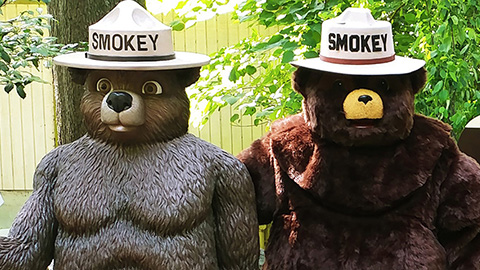
Extreme wildfires tore through California, burning more than 4.2 million acres from 2020 through 2021. The fires were like none ever recorded in modern history. Their devastation of human communities was well-documented, but their toll on wildlife was largely unknown.
Gavin Jones, an ecologist with the U.S. Department of Agriculture's Forest Service Rocky Mountain Research Station, saw possible connections between these extreme events and Australia’s deadly bushfires in 2019-2020.
“Tragically, the bushfires killed or displaced almost 3 billion animals. It made me wonder what was happening to our wildlife,” Jones said.

Jones and fellow researcher, Jessalyn Ayars, made it their mission to find out. Their efforts focused on how wildlife contended with extreme wildfires in the Sierra Nevada, southern Cascades, and Klamath Mountains.
“We wanted to get a 30,000-foot view of what was happening to 600 species,” said Jones. “California is ideal for this research because their Department of Fish and Wildlife has an extensive database on hundreds of species.”
Jones and Ayars combed through the state’s wildlife database, looking at the geographic range of species and species habitat suitability models. These models use statistical methods to determine where species most likely live based on their habitat preferences. The researchers then overlaid the species data with the location and size of an area burned, factoring in fire severity levels. Piecing all this information together, like a jigsaw puzzle, they formed a picture of what was happening to wildlife on the ground.
This required some fancy computer footwork.

“Imagine taking one species map and overlaying fire maps for all of California and multiply that by six hundred. It was extremely time consuming,” Ayars stated.
Using parallel computing, Ayars could tap into a super freeway of resources and compile information on each species much more efficiently.
“I divided computing tasks into different jobs that could be run at the same time,” Ayars continued.
Jones used the analogy of a freeway to understand parallel computing.
“Imagine sitting in your car on a congested one-lane road, trying to get home. Now, imagine a 600-lane superhighway where traffic can travel in several different lanes simultaneously. You’ll arrive at your destination much faster,” Jones said.

It took Jones and Ayars about a year to compile their research findings, and the results are sobering. Out of more than 600 species, 50 species experienced fire in 15 to 30 percent of their geographic range. One hundred species contended with fire in more than 10 percent of their habitat, including great gray owls, Pacific martens, wolverines, northern rubber boas, and other species of concern. The long-toed salamander faced high-severity fire across 14 percent of its range, which was more than any other species. The long-term effects of fire on the salamander are uncertain.
Although the research findings are unsettling, there is hopeful news. Large wildfires burned less habitat where birds and reptiles of conservation concern live than researchers expected.
Jones and Ayars emphasized that their research is not stating that wildfires inherently destroy wildlife habitat. On the contrary, moderate, and low-intensity fires are vital for healthy ecosystems.
Pacific Southwest Research Station Ecologist John Keane agreed.

“Fire creates a diversity of habitats. It clears out the forest floor, reducing risk to old growth trees and dense forest patches that support many species,” said Keane. “Fire can create conditions to support growth of future old growth trees that provide cavities for spotted owls, fishers, and Pacific martens to nest and den.”
Most wildlife, however, are not adapted to expansive high-severity wildfires. Fueled by climate change and past fire suppression, fires are becoming more frequent and severe. Compounding this, as climate change intensifies, trees battle prolonged droughts and insect infestations. For some trees, it’s a losing fight. Over time, extreme wildfires can convert entire forests to grasses and shrubs where wildlife, dependent on native forests, can no longer survive. That’s especially worrisome in California, which is home to over 700 vertebrate species, and considered the most biodiverse state in the U.S.
Keane is particularly concerned about what this research means for spotted owls, another species of concern.
“Non-native barred owls are already encroaching on spotted owl habitat, placing them at risk,” said Keane.
“Wildfire disasters can destroy old-growth trees and dense forest patches upon which spotted owls depend for nesting, roosting, and foraging. Many of those trees are hundreds of years old and take a long time to regenerate and replace within the forest.”
Pollinators may also be at risk from fires that burn large swaths of habitat at high severity. Pacific Southwest Research Station Wildlife Biologist Angela White, fellow researcher Gina Tarbill, and Rahel Sollmann from UC Davis published findings on how high-severity fires impact pollinators in Sierra Nevada meadows.
“Severe fire may directly kill pollinators by burning faster than species can flee or burning deeper into the soil, killing those that shelter underground. In contrast, pollinators tended to respond more positively to moderate severity fire in uplands. Moderate fire opens the canopy and provides space, light, and water for a diverse flower community upon which pollinators depend.”

Jones and Ayars want to see more research, like that on pollinators, that sheds light on how extreme wildfires affect individual species.
“We hope our research inspires other scientists to learn more or possibly replicate what we’ve done in other states,” said Jones.
They hope the public and forest managers can also learn from the research, which highlights the importance of prescribed fires for undergrowth management.
“Increasing the pace and scale of tree thinning and prescribed burning could mitigate the extensive stand-replacing fire effects we observed, and their effects on wildlife,” said Jones. “That will help make forests resilient, which is crucial for protecting wildlife.”






